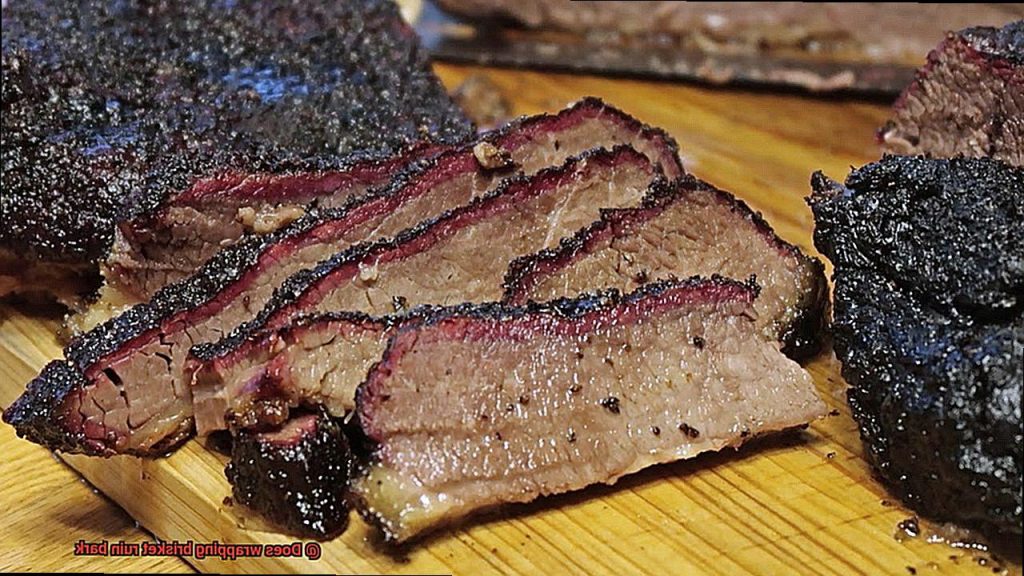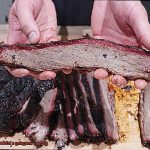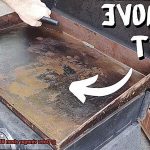Are you a pitmaster or a smoked meat enthusiast? If so, then you’re probably familiar with the heated debate surrounding whether or not wrapping brisket ruins the coveted bark. Bark is the crispy, flavorful layer that forms on top of smoked meats, and it’s a crucial aspect of achieving that perfect BBQ flavor. But does wrapping brisket in foil or butcher paper ruin all your hard work?
Some pitmasters swear by wrapping brisket to achieve maximum juiciness and tenderness, while others argue that doing so takes away from the texture and flavor of the meat. This debate has been raging for years and remains one of the most hotly discussed topics in the world of BBQ.
But what’s the truth? Is there a definitive answer to this question? In this blog post, we’ll delve into the science behind smoking meats, explore various wrapping methods, and weigh up their pros and cons. Our ultimate goal is to determine whether wrapping really does ruin the bark or if it’s just an unfounded myth.
So whether you’re an experienced pitmaster or just starting out on your smoking journey, keep reading to discover if wrapping brisket truly affects the taste and texture of your beloved smoked meats.
Contents
What is Wrapping and How Does it Affect the Bark?
Wrapping is a common method used to keep meat moist and tender during the smoking process. It involves tightly wrapping the meat in foil or butcher paper after a few hours of smoking, which allows the meat to continue cooking in its own juices. However, this technique can also have an impact on the bark, the flavorful crust that forms on the outside of the meat during smoking.
The bark is created by a combination of smoke, heat, and seasoning, and is highly prized by barbecue enthusiasts for its intense flavor and texture. But when meat is wrapped, it can trap moisture inside the foil or paper, creating steam that can soften the bark. Additionally, the lack of airflow around the meat can prevent the bark from developing further.
While some argue that wrapping brisket ruins the bark and leads to a less flavorful end product, others believe that it actually enhances texture and flavor by creating a more tender result. Ultimately, whether or not you choose to wrap your brisket depends on your personal preference and desired outcome.
If you’re looking to achieve a great bark regardless of whether or not you choose to wrap your brisket, there are some tips to keep in mind. Firstly, use a rub with plenty of salt and sugar to create a flavorful crust on the outside of the meat. Secondly, ensure that your smoker stays consistent throughout the cooking process by monitoring temperature carefully. Thirdly, use wood chips or chunks to add smoky flavor and help develop the bark. Fourthly, avoid opening the smoker too often as this can disrupt airflow and prevent proper bark formation. Lastly, let your brisket rest for at least 30 minutes after cooking to allow juices to redistribute and prevent dryness.
Pros and Cons of Wrapping Brisket
Here, we will explore the pros and cons of wrapping brisket when smoking or grilling, so grab a cold beer and let’s dive in.
Pros:
- Faster and more even cooking: Wrapping your brisket helps to trap heat and moisture, creating a steaming effect that breaks down tough muscle fibers and promotes collagen breakdown. Consequently, your brisket cooks faster and more evenly.
- Moisture retention: Wrapping your brisket also keeps the meat moist and tender, which is crucial when cooking a large brisket or smoking it for an extended period of time.
- Prevention of overcooking: Wrapping your brisket can also prevent it from drying out or becoming overcooked, which could lead to tough, chewy meat.
Cons:
- Interference with bark development: The wrap may interfere with the development of a crispy, flavorful bark on the outside of the brisket. This is because it traps in moisture, preventing the surface from drying out and forming a crust.
- Texture issues: Wrapping your brisket can result in overly soft or mushy meat, rather than achieving a satisfying chewiness that some people prefer.
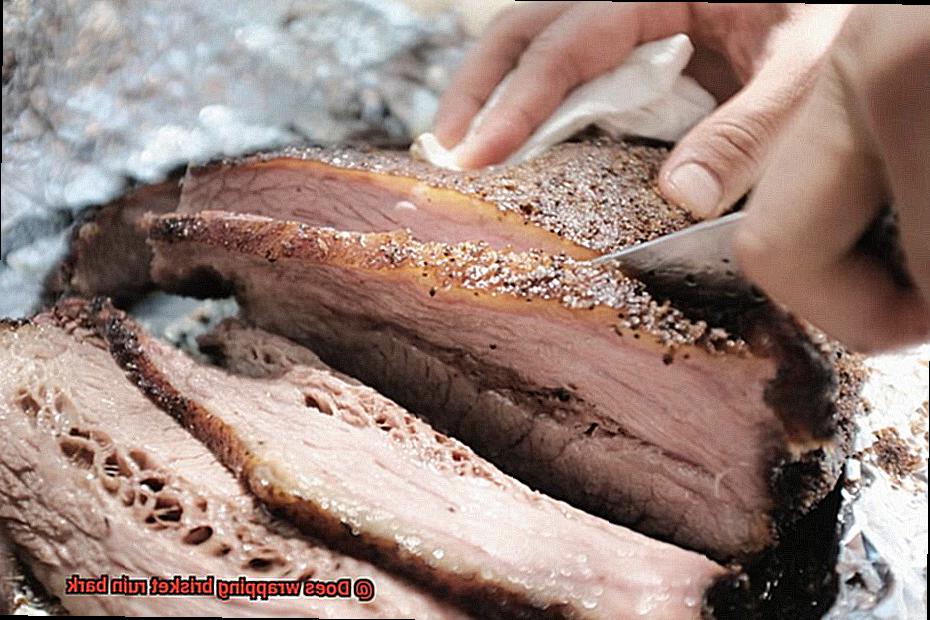
Tips for Creating the Perfect Bark
Achieving the perfect bark is a skill that takes practice, patience, and attention to detail. Here are five tips to help you create the perfect bark on your brisket.
Choose the Right Wood
The type of wood you use for smoking your brisket plays a crucial role in forming a beautiful bark. Hardwoods like oak, hickory, and pecan are ideal for giving your brisket a smoky flavor and creating a mouth-watering crust on the outside.
Use a Rub with Sugar
A good rub is essential for creating the perfect bark on your brisket. A rub with sugar helps to caramelize the meat, resulting in a crispy exterior. However, it’s important to balance the sweetness with other spices like salt, paprika, and garlic.
Maintain Consistent Temperature
Temperature control is another critical factor when it comes to forming a perfect bark on brisket. Fluctuations in temperature can cause the bark to become tough or even burn. Using a smoker with a built-in thermometer or a separate thermometer to monitor the temperature can help maintain consistency.
Consider Wrapping
Wrapping your brisket in foil or butcher paper can help keep it moist and prevent it from drying out during cooking. However, wrapping too early can result in a softer bark, while wrapping too late can cause the meat to dry out. Experiment with wrapping at the right time to find what works best for you.
Be Patient
Creating the perfect bark on your brisket takes time and patience. Starting with a good rub and maintaining consistent temperature throughout the smoking process are crucial steps. With practice, you’ll be able to achieve an irresistible crispy exterior that will impress any barbecue enthusiast.
Popular Methods for Wrapping Brisket
One of the most controversial topics in the BBQ world is whether or not to wrap your brisket while smoking. Wrapping can speed up the cooking process and keep your meat moist, but it can also soften the bark, which is the crispy exterior that forms on the meat during smoking.
There are three main methods for wrapping brisket: butcher paper, foil, and no wrap. Butcher paper is a popular choice among pitmasters because it allows for some airflow while still retaining moisture. It’s also readily available at your local grocery store. Foil completely seals in the moisture and creates a steaming effect that makes your meat incredibly tender. However, some argue that it can also soften the bark too much and take away from that coveted crunch. Finally, some pitmasters prefer not to wrap at all and let the brisket cook uncovered for the entire cooking time. This method allows for maximum bark development and a firmer texture.
The debate over whether or not wrapping brisket ruins the bark has been ongoing for years. Proponents of wrapping argue that it helps to keep the meat moist and speeds up the cooking process, resulting in a more evenly cooked piece of meat. On the other hand, those against wrapping believe that it softens the bark and takes away from the overall texture of the brisket.
Ultimately, which method you choose depends on your personal preference and what kind of bark you’re looking for. If you want a balance of moisture and bark texture, then butcher paper is a great option. If you prioritize tenderness over crunch, then foil is perfect for you. And if you’re all about that bark, then no wrap is the way to go.
Different Types of Wraps for Brisket
As any pitmaster knows, the perfect brisket requires a balance of tender, juicy meat and a crispy, flavorful bark. One way to achieve this balance is by using different types of wraps during the smoking process. Here are the pros and cons of some common wrap options:
Butcher paper
Butcher paper is a classic choice for wrapping brisket. It allows the meat to breathe while still protecting it from the heat. This type of wrap also helps to retain moisture, which is critical for a juicy brisket. However, some pitmasters argue that butcher paper can still affect the bark slightly by preventing it from getting as crispy as it would without any wrap.
Foil
Foil is often used by pitmasters who want to keep their brisket moist and tender. The foil wrap prevents moisture from escaping, which can help to prevent the brisket from drying out. However, foil can also cause the bark to become soft and lose its texture. Additionally, some pitmasters believe that wrapping in foil for too long can cause the meat to become overly tender and lose its structural integrity.
Peach paper
Peach paper is similar to butcher paper but has a food-grade wax coating that creates a tighter seal around the meat. This allows it to retain moisture while still allowing some airflow for a crispy bark. Peach paper has become increasingly popular among pitmasters because it provides many of the benefits of both butcher paper and foil without any of their drawbacks.
Cloth
Wrapping brisket in cloth is less common than other methods but can still be effective. Cloth allows the meat to breathe while also providing a tighter seal than butcher paper. However, cloth can be difficult to work with and may require pre-washing before use.
No wrap
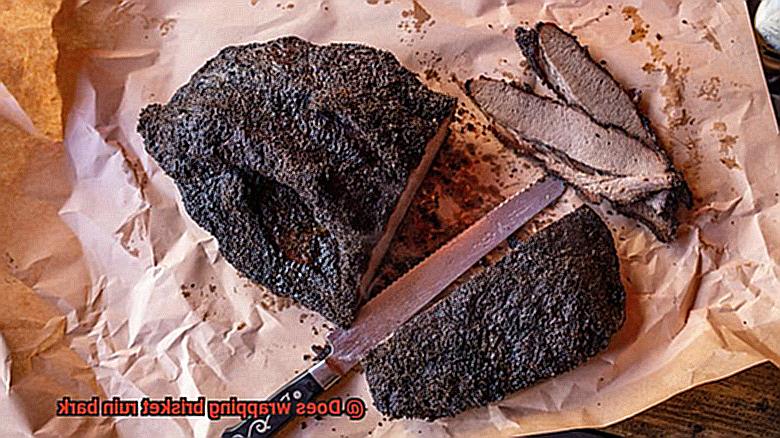
Some pitmasters prefer not to wrap their brisket at all, arguing that this allows them to achieve a better bark and more pronounced smoke flavor. However, cooking an unwrapped brisket requires much more attention and skill than wrapping, as the meat is more prone to drying out or becoming tough if not cooked properly.
How to Avoid Softening the Bark When Wrapping Brisket
As a pitmaster, you know that the bark on a brisket is crucial to its flavor and texture. Wrapping your brisket can help it cook faster and stay moist, but it can also cause the bark to soften. Don’t worry – we’ve got some tips to keep your brisket bark crispy and delicious.
Use the “Texas Crutch” Technique
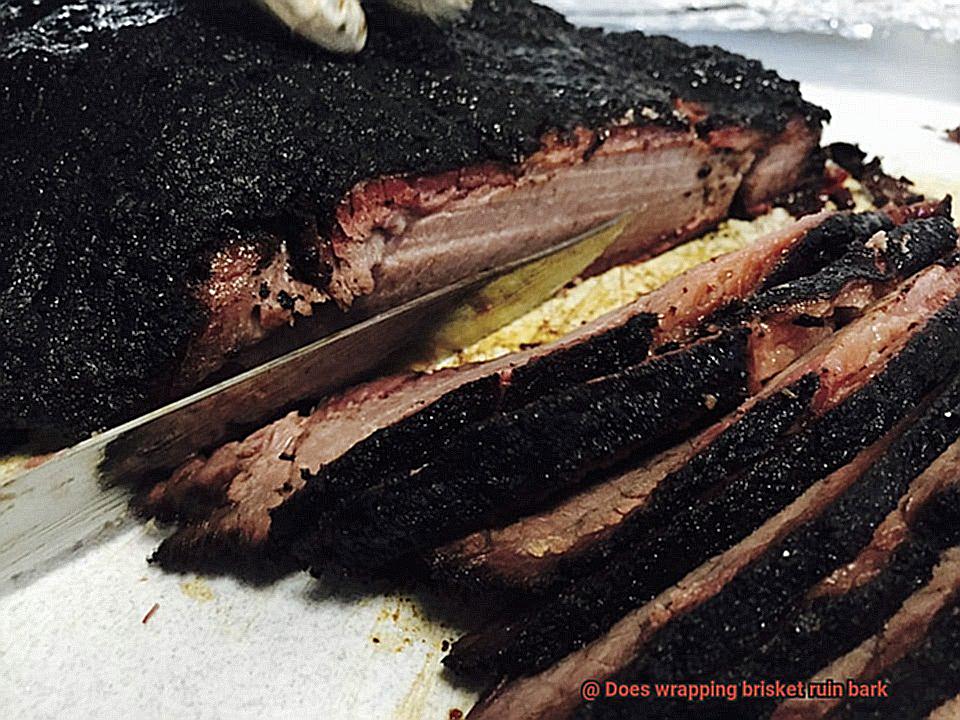
The “Texas crutch” technique involves wrapping your brisket in foil or butcher paper for part of the cooking time and then unwrapping it for the remainder. This allows the bark to firm up and become crispy while still getting the benefits of wrapping.
Use a Wire Rack
When wrapping your brisket, place it on a wire rack before wrapping to allow air to circulate around the meat. This will prevent moisture from getting trapped against the bark and keep it crispy.
Wrap at the Right Time
Wait until your brisket reaches an internal temperature of around 160-170°F before wrapping it. At this point, it has already absorbed enough smoke to start forming a bark.
Avoid Adding Moisture
When wrapping your brisket, avoid adding any liquid or moisture to the wrap. This steamy environment can cause the bark to soften and become mushy. Simply wrap your brisket tightly without any added liquids.
Unwrap for the Final Hour
Unwrap your brisket for the final hour of cooking to allow the surface of the meat to dry out and re-crisp. This will restore some of the texture that may have been lost during wrapping and ensure that your bark is crispy all over.
Pitmasters’ Opinions on Wrapping Brisket
When it comes to the great debate over whether or not to wrap brisket, pitmasters have varying opinions. On one side, we have the “wrappers” who believe that wrapping brisket in foil or butcher paper helps to retain moisture and create a tender final product. They argue that it allows for a more consistent cook by preventing the meat from drying out during long cooks, which can take anywhere from 10-18 hours. Wrapping can also help break down connective tissue, making the brisket even more tender.
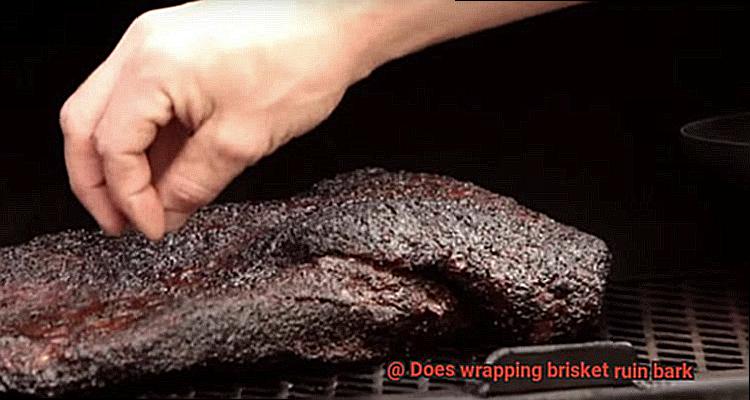
However, the “non-wrappers” argue that wrapping can result in a loss of texture and flavor. They claim that wrapping with foil or butcher paper can cause the bark to become soft and mushy, which is a cardinal sin in the barbecue world. Additionally, wrapping can trap steam and prevent smoke from penetrating the meat, leading to a less pronounced smoky flavor.
Ultimately, whether or not to wrap brisket comes down to personal preference and experimentation. Some pitmasters swear by wrapping their brisket, while others refuse to do so. It’s important to consider your own preferences and cooking style when deciding whether or not to wrap your next brisket.
If you do decide to wrap your brisket, there are a few things to keep in mind. Timing is crucial – you want to wait until the brisket has developed a decent bark before wrapping. This usually happens around the 4-6 hour mark but can vary depending on your smoker and cooking temperature. When choosing your wrapping material, foil is great for retaining moisture but can also cause the bark to soften. Butcher paper is a popular choice among pitmasters because it allows for some airflow while still retaining moisture.
It’s also important to remember to unwrap your brisket for the last hour or so of cooking. This will help re-crisp the bark and prevent it from becoming too soft.
Best Practices for Wrapping Brisket
Then it’s time to dive into the best practices for wrapping brisket. As an expert in the world of barbecue, I have experimented with various techniques over the years and here are my top tips for achieving the perfect brisket.
Timing is critical when it comes to wrapping brisket. While some pitmasters swear by the “Texas crutch” method of wrapping the brisket in foil or butcher paper after a few hours of smoking, this can soften the bark. If you’re aiming for a crispy exterior, wait until the meat forms a good crust and deep mahogany color before wrapping it. Depending on the size of your brisket and smoker, this can take anywhere from 4-6 hours or more.
Once you’ve determined the ideal timing, consider how tightly to wrap your brisket. A tight wrap can help keep the meat moist, but it can also cause steam to build up inside the foil or paper, which can soften the bark. On the other hand, a looser wrap allows some air circulation and preserves the bark’s crispy texture. Experiment with different wrapping techniques and find what works best for you.
Remember that there are numerous approaches to wrapping brisket, and what works best for one person may not work for another. Whether you prefer foil or butcher paper as your wrapping material, make sure you’re using high-quality products that won’t break or leak during cooking.
In addition to timing and wrapping techniques, pay attention to your smoking environment. Maintain a consistent temperature throughout the cooking process and avoid opening the smoker too often, as this can disrupt airflow and affect cooking times.
Conclusion
In the world of barbecue, the age-old question of whether to wrap brisket remains a hotly debated topic. While wrapping in foil or butcher paper is a popular method for keeping meat moist and tender during smoking, it can also have an impact on the bark – that delicious crust that forms on the outside of smoked meats. Some pitmasters swear by wrapping for maximum juiciness and tenderness, while others argue that it takes away from texture and flavor. So, what’s the truth?
The answer ultimately depends on your personal preference and desired outcome. Wrapping can speed up cooking time and keep meat moist, but it can also soften the bark. To achieve a great bark regardless of whether or not you choose to wrap your brisket, use plenty of salt and sugar in your rub, monitor temperature carefully, use wood chips or chunks for smoky flavor, avoid opening the smoker too often, and let your brisket rest after cooking.
- There are pros and cons to wrapping brisket – faster cooking time and moisture retention versus interference with bark development and texture issues. Popular methods for wrapping include butcher paper, foil, peach paper (a combination of both), cloth (less common), or no wrap at all. The key is experimentation to find what works best for you.
- Timing is critical when it comes to wrapping brisket – wait until the meat forms a good crust before wrapping tightly or loosely depending on your preference. Use high-quality products that won’t break or leak during cooking while maintaining consistent temperature throughout the process.
In conclusion, there’s no one-size-fits-all answer when it comes to wrapping brisket. It’s all about finding what works best for you based on personal preference and desired outcome.

